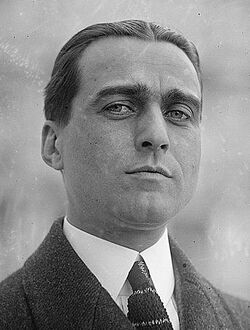Difference between revisions of "US/Ambassador/Spain"
m (Robin moved page United States Ambassador to Spain to US/Ambassador to Spain) |
(a bit short, but - unstub) |
||
| (2 intermediate revisions by one other user not shown) | |||
| Line 1: | Line 1: | ||
{{employment | {{employment | ||
|wikipedia=https://en.wikipedia.org/wiki/United_States_Ambassador_to_Spain | |wikipedia=https://en.wikipedia.org/wiki/United_States_Ambassador_to_Spain | ||
| − | |constitutes=Ambassador | + | |constitutes=Ambassador to Spain |
|interests=Spain | |interests=Spain | ||
| + | |image=James Clement Dunn 1921.jpg | ||
| + | |image_caption=Ambassador [[James Clement Dunn]] worked on policies to establish a good relationship with [[Francisco Franco]]. | ||
|start=September 29, 1779 | |start=September 29, 1779 | ||
|website=http://madrid.usembassy.gov/ | |website=http://madrid.usembassy.gov/ | ||
| + | |description=The US ambassador to Spain | ||
}} | }} | ||
| + | The '''US Ambassador to Spain''' is the [[United States]]' highest diplomatic representative to [[Spain]]. | ||
| + | |||
| + | ==Overview== | ||
| + | As the [[Cold War]] deepened after 1950, Washington threw a lifeline to the [[Francoist dictatorship]] that included financial aid and military bases. Membership in [[NATO]] came in 1982, after [[Francisco Franco]]'s death and the [[Spanish transition to democracy]].<ref>[https://books.google.com/books?id=i6YuAgAAQBAJ&pg=PA481 The Age of the Dictators: A Study of the European Dictatorships, 1918–53] </ref> | ||
| + | |||
| + | Between 1969 and 1977, the period comprising the mandates of [[Henry Kissinger]] as National Security advisor and as Secretary of State of the US during the [[Richard Nixon|Nixon]] and [[Gerald Ford|Ford]] administrations, the US foreign policy towards [[Spain]] was driven by the American need to guarantee access to the military bases on Spanish soil. Military facilities of the United States in Spain built during the Franco era include [[Naval Station Rota]] and [[Morón Air Base]], and an important facility existed at [[Madrid-Torrejón Airport|Torrejón de Ardoz]] near [[Madrid]]. Torrejón passed under Spanish control in [[1988]]. Rota has been in use since the 1950s. Crucial to Cold War strategy, the base did have [[nuclear weapons]] stationed on it for some time, and at its peak size, in the early 1980s, was home to 16,000 sailors and their families. The presence of these bases in Spain was much unpopular among the Spanish people (according to a 1976 poll by [[Louis Harris]] International, only 1 out of 10 Spaniards supported the American presence in the country).<ref>Powell, Charles (2007). [Henry Kissinger y España: de la dictadura a la democracia (1969–1977)". Historia y Política. Ideas, Procesos y Movimientos Sociales https://recyt.fecyt.es/index.php/Hyp/article/view/44570/26145]. Madrid: UCM; CEPC; UNED: 223–251. ISSN 1575-0361, page 251</ref> The continuation of the bases became priority for US diplomats. | ||
| + | |||
| + | |||
| + | |||
| + | |||
| + | |||
{{SMWDocs}} | {{SMWDocs}} | ||
==References== | ==References== | ||
{{reflist}} | {{reflist}} | ||
| − | |||
Latest revision as of 04:36, 10 April 2024
(Ambassador to Spain) | |
|---|---|
 Ambassador James Clement Dunn worked on policies to establish a good relationship with Francisco Franco. | |
| Start | September 29, 1779 |
| Interests | Spain |
| Website | http://madrid.usembassy.gov/ |
| The US ambassador to Spain | |
The US Ambassador to Spain is the United States' highest diplomatic representative to Spain.
Overview
As the Cold War deepened after 1950, Washington threw a lifeline to the Francoist dictatorship that included financial aid and military bases. Membership in NATO came in 1982, after Francisco Franco's death and the Spanish transition to democracy.[1]
Between 1969 and 1977, the period comprising the mandates of Henry Kissinger as National Security advisor and as Secretary of State of the US during the Nixon and Ford administrations, the US foreign policy towards Spain was driven by the American need to guarantee access to the military bases on Spanish soil. Military facilities of the United States in Spain built during the Franco era include Naval Station Rota and Morón Air Base, and an important facility existed at Torrejón de Ardoz near Madrid. Torrejón passed under Spanish control in 1988. Rota has been in use since the 1950s. Crucial to Cold War strategy, the base did have nuclear weapons stationed on it for some time, and at its peak size, in the early 1980s, was home to 16,000 sailors and their families. The presence of these bases in Spain was much unpopular among the Spanish people (according to a 1976 poll by Louis Harris International, only 1 out of 10 Spaniards supported the American presence in the country).[2] The continuation of the bases became priority for US diplomats.
Office Holders on Wikispooks
| Name | From | To | Description |
|---|---|---|---|
| Reginald Bartholomew | 1986 | 1989 | Bilderberger |
| Thomas O. Enders | 15 September 1983 | 6 July 1986 | |
| Terence Todman | 20 July 1978 | 8 August 1983 | |
| Robert C. Hill | 12 June 1969 | 12 January 1972 | |
| Robert F. Wagner Jr | 24 June 1968 | 7 March 1969 | |
| James Clement Dunn | 9 April 1953 | 9 February 1955 |
References
- ↑ The Age of the Dictators: A Study of the European Dictatorships, 1918–53
- ↑ Powell, Charles (2007). [Henry Kissinger y España: de la dictadura a la democracia (1969–1977)". Historia y Política. Ideas, Procesos y Movimientos Sociales https://recyt.fecyt.es/index.php/Hyp/article/view/44570/26145]. Madrid: UCM; CEPC; UNED: 223–251. ISSN 1575-0361, page 251